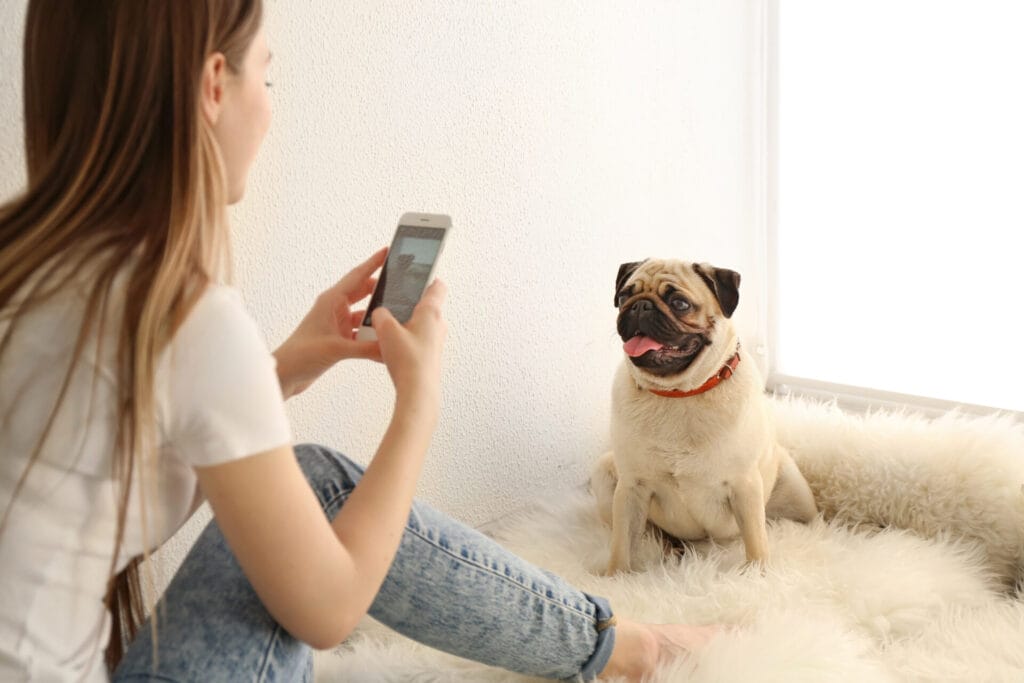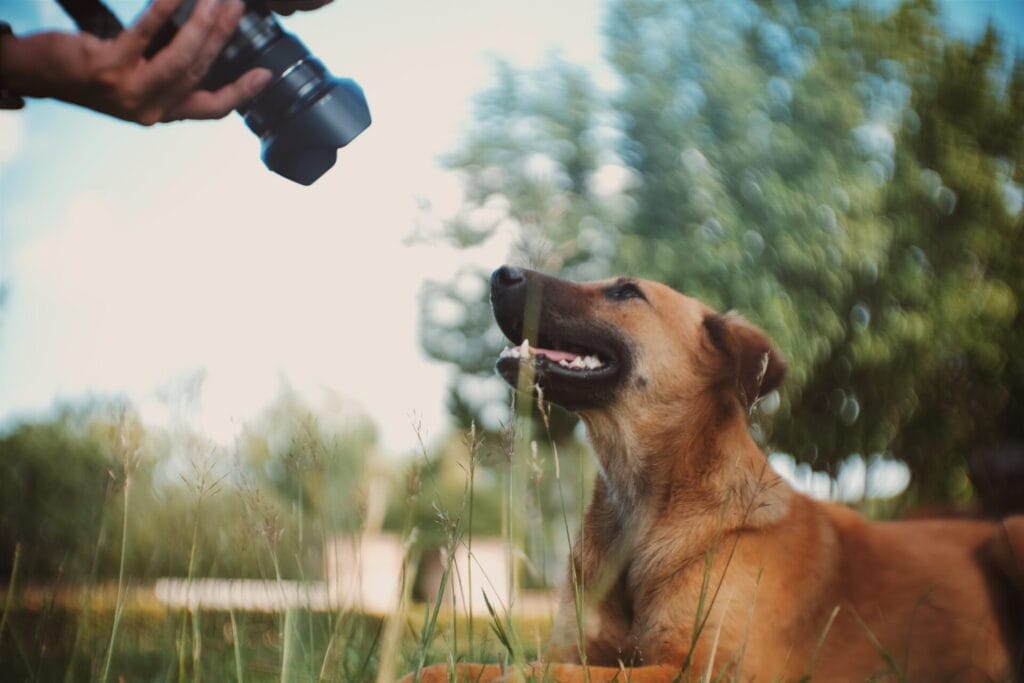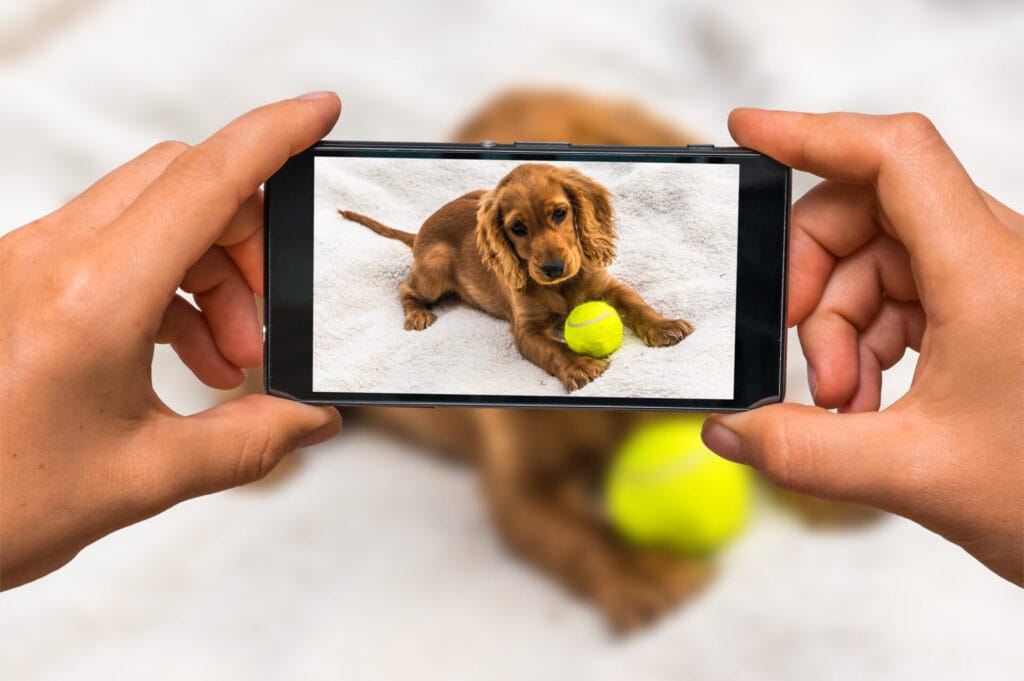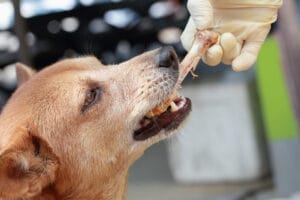Dogs are the perfect subjects for all kinds of pet photography. Their energy, unpredictability, and joy can be turned into eye-catching dog photography. But they aren’t always the easiest to capture! Here are some helpful and easy tips we have gathered on capturing your dog(s) with a professional camera or a smartphone to get the best shots imaginable.
Learn about your subject before the shoot
Portrait photographers often get to know their clients before the photo session. By understanding their personalities, you can better know what to avoid and how to give instructions. You can use the same technique when photographing dogs. If your dog is very energetic, you’ll be able to prepare yourself for a fast-paced and unpredictable photo shoot. If they enjoy lazing around, you can bring a few tasty treats with you to catch their attention. Observe your subject and include their strengths in your pictures for the most natural results.

Add pops of color to the photo
You can use nature, a bright wall, furniture, a colorful leash, collar, or even an outfit to accomplish this. Incorporate bright colors or accessories into the shot for some contrast!
Use your existing smartphone settings
You have some of the finest photography tools right in your pocket! On the iPhone camera, you can click on the screen and play around with the exposure settings. A nice, overcast day helps for an overall even exposure.
Work with your dog’s best feature
Does your dog have a beard that makes the hipsters swoon? A unique spot on their fur, perhaps? Find what truly makes them stand out and highlight it. It may be their expressive eyes, a bold side profile, a cool trick, a long floppy tongue, or even their unique bond with their humans. Take a moment to find that trait to focus on in each photo. Where details may lack in shadows, let personality make them stand out and shine.
Lighting is the most important aspect
It’s especially true when trying to photograph a dog that is darker in color. If you don’t have access to external lights, take your dog outdoors or in front of a well-lit window indoors and face them into the light; this will help fill all those shadows on their face and fur and give a sparkle to their eyes. Soft light can really be your best friend. Try to avoid direct midday sun because the color of your dog & the white light of the sun battle one another. Opt for shady areas, overcast days, or golden hour lighting instead!
The best times to take beautiful dog photography:
-The golden hour: shortly after sunrise or before sunset, the sun creates a hazy, golden atmosphere that’s ideal for joyful photos.
-A cloudy day: clouds won’t help you take bright photos. But they’ll create a pleasant glow. This will help you take well-lit photos no matter where your pet goes.

Focus on the eyes
Emotive dog portraits focus on the eyes, much like human portraits. You can use the eyes to create depth, emphasize an unusual eye color, or create a sense of familiarity. Use a wide aperture (f/2.8 or lower) to enhance this feeling! Often, the puppy won’t start posing as soon as you pick up your camera. Try taking emotive portraits at the end of your photoshoot. That’s when your subject has used up all of their energy and is ready to relax.
Burst mode can be your best friend
Continuous shooting (burst mode) is perfect for taking epic and hilarious photos of dogs. Active dogs are unpredictable. This means you won’t be able to compose a shot during your session. Instead of waiting for the perfect moment, take as many spontaneous images as you can. Burst mode is a handy feature allowing you to take many pictures within seconds. You’ll capture all kinds of angles and expressions while your dog is running.
Zoom in to give the dog some space
It’s important to give your subject enough space to feel comfortable. Especially if it’s not your own pet. A dog will be more inclined to play around with the right amount of space. They’ll probably forget that the camera is even there. But they may not forget if you’re standing close and staring at it through a lens. A zoom lens will help you take high-quality photos of your subject from a distance. This will help the dog get used to your presence. And it will give you enough space to experiment. You can try different compositions, crop out distractions, and create gorgeous bokeh.
Portrait Mode is your friend
On models of phones that support portrait mode, you can apply a depth-of-field effect that keeps your subject—people, pets, objects, and more—sharp while creating a beautifully blurred foreground and background. You can apply and adjust different lighting effects to your portrait mode photos, and on iPhone X and later, you can even take a selfie of your dog in Portrait mode.
Avoid camera shake
You’ll hold the camera or phone more still if you hold your breath while taking the photo. It also helps to rest your elbows on something, whether it’s a table or fence post. Sometimes a camera or phone can be more sensitive to minor shakes.
Every dog lover deserves to have great dog photography. With a bit of practice, you can learn how to work with different personalities. Master how to shoot strategically and adapt to various camera and phone settings. You’ll become a skilled dog photographer in no time.
You can still use these pet photography tips even if you’re not planning to become a pro. They will help you take the best possible photos of your beloved pet.




















